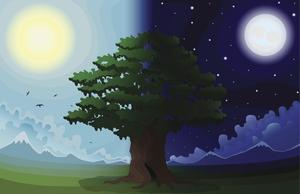Glossary term: 地轴
Description: 地轴是一条假想的直线,地球每天围绕它旋转一圈。地轴与地球表面相交的两个位置是地理北极(北纬 90°)和地理南极(南纬 90°)。与此相对,赤道也是一条假想线,是垂直于地轴的平面与地球表面相交的大圆,与地轴的距离最远。赤道的纬度为 0°。
地理南北极与地球磁场南北极的位置不同--磁极定义为地球表面上地磁场方向竖直向上和竖直向下的点。
地球公转轨道也有一个轴:方向与地球轨道平面垂直。地轴与轨道轴夹角 23.4°。这一夹角是地球四季变化的原因。特别是,在一个轨道周期中,北半球或南半球会向太阳倾斜,从而接收到更多的光。
相对于最遥远的天体,地轴指向的方向会随着时间的推移而缓慢变化,这就是所谓的岁差(地轴近动)。目前,地轴与天球相交的位置接近北极星。但在大约 2.6 万年的时间里,这个交点会在天空中画出一个小圆圈。以地球为参照定义的天球坐标系需要考虑到由此产生的随时间推移的微小坐标偏移。
Related Terms:
See this term in other languages
Term and definition status: The original definition of this term in English have been approved by a research astronomer and a teacher The translation of this term and its definition is still awaiting approval
The OAE Multilingual Glossary is a project of the IAU Office of Astronomy for Education (OAE) in collaboration with the IAU Office of Astronomy Outreach (OAO). The terms and definitions were chosen, written and reviewed by a collective effort from the OAE, the OAE Centers and Nodes, the OAE National Astronomy Education Coordinators (NAECs) and other volunteers. You can find a full list of credits here. All glossary terms and their definitions are released under a Creative Commons CC BY-4.0 license and should be credited to "IAU OAE".
If you notice a factual or translation error in this glossary term or definition then please get in touch.
Related Activities
Why Do We Have Day and Night?
astroEDU educational activity (links to astroEDU website) Description: Explore day and night of Earth.
License: CC-BY-4.0 Creative Commons 署名 4.0 国际 (CC BY 4.0) icons
Tags:
Tilt
Age Ranges:
6-8
, 8-10
, 10-12
Education Level:
Primary
, Secondary
Areas of Learning:
Modelling
, Structured-inquiry learning
, Social Research
Costs:
Low Cost
Duration:
1 hour 30 mins
Group Size:
Group
Skills:
Asking questions
, Communicating information









